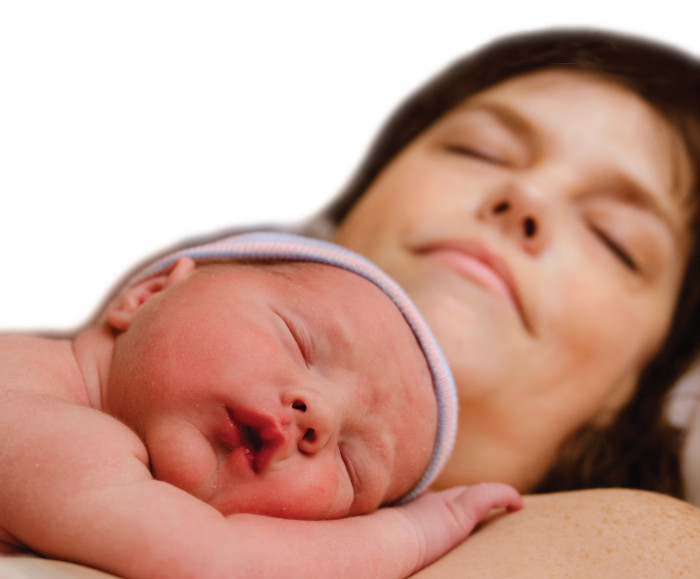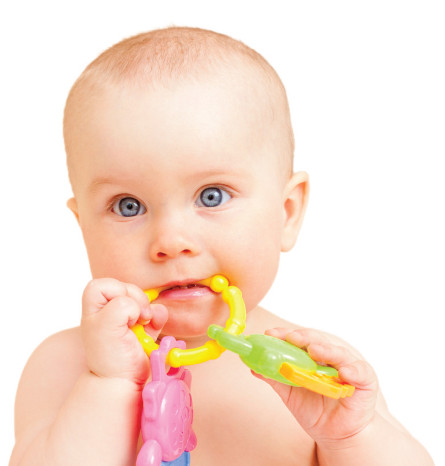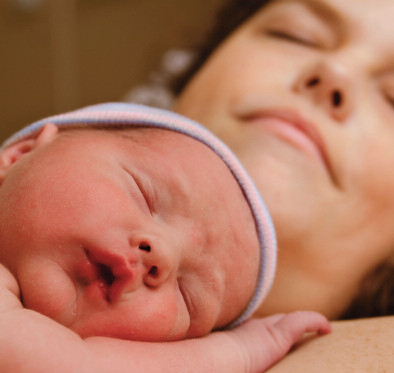In Conditions
Follow this topic
Bookmark
Record learning outcomes
Â

It is always a relief to know that the mother and baby are both doing well after a birth but sadly that doesn’t happen with every pregnancy
Learning objectives
After reading this feature you should be able to:
- Discuss the latest data on UK maternal mortality rates
- Explain the importance of flu vaccination for pregnant women
- Outline the recommended approaches to managing common ailments in babies.
Â
According to a recent report1, maternal mortality rates in the UK are continuing to decline, falling from 11 deaths per 100,000 women giving birth in 2006-2008 to 10 deaths per 100,000 in 2010-2012. Of the deaths that did occur, only one-third was due to direct complications of pregnancy (e.g. bleeding and pre-eclampsia).
The remaining two-thirds were attributable to pre-existing medical and chronic mental health problems that were poorly controlled during pregnancy. Key causes of maternal death included epilepsy, diabetes, heart disease and suicide.
The report also found that one in every 11 deaths that occurs during pregnancy in the UK is due directly to flu. According to MBRRACE-UK, an initiative led by the national perinatal epidemiology unit at the University of Oxford: “The importance of influenza immunisation for pregnant women cannot be overemphasised… Increasing immunisation rates in pregnancy against seasonal influenza must remain a public health priority.â€
Women are at increased risk of severe illness, complications and hospitalisation if they contract influenza during pregnancy, says the NICE clinical care summary on antenatal care2. This is due to changes to the immune system and major organ systems (specifically the heart and lungs) that take place during pregnancy.
Influenza can additionally cause harm to the developing foetus and there is evidence that infection may be linked with premature labour and a smaller infant size at birth2. Flu during pregnancy is also associated with an increased risk of stillbirth and even death during the first week of an infant’s life3. Given the proven, yet preventable, risks to both mother and baby, pharmacists should advise all pregnant customers to take up the annual flu vaccine which is available free of charge through the NHS.
Key lifestyle advice
Following a well-balanced diet and maintaining a healthy lifestyle is important for all pregnant women, and pharmacy staff are well-placed to offer advice on how to achieve this. NICE recommends the following essential dietary advice for all pregnant women2:
• Eat a varied diet containing plenty of fruit and vegetables, lean protein, starches, high-fibre/ wholegrain foods and dairy
• Consume foods rich in folic acid and vitamin D
• Peanuts can be eaten during pregnancy as there is no clear evidence that this affects the likelihood of the unborn baby developing a peanut allergy
• Avoid potential ‘high-risk’ foods, such as mould-ripened cheese, pâté, liver, raw shellfish, unpasteurised milk.
The Food Standards Agency additionally advises that pregnant women limit their consumption of tuna to two medium cans or one fresh tuna steak per week (due to the high mercury content) and restrict caffeine intake to 300mg/day (excess caffeine can affect birth weight)2. All pregnant women should be advised to take 400mcg folic acid and 10mg of vitamin D daily. Iron supplementation should not be offered unless the woman is known to be anaemic and vitamin A supplements should be avoided completely as an intake greater than 700mcg per day is a proven teratogen2.
Alcohol can be a confusing topic for pregnant women as advice on acceptable limits is conflicting and continually changing. As a general rule, both NICE and the NHS recommend that women abstain from alcohol completely during pregnancy2. Alcohol can increase the rate of spontaneous abortion and pre-term delivery, affect foetal birthweight, size and growth, and raise the risk of foetal alcohol syndrome2. However, there is currently no clear evidence of harm to the unborn infant if one to two alcohol units are consumed once or twice a week.
If a woman does choose to drink during her pregnancy, advise her to stick to these limits and avoid getting drunk or binge drinking. All pregnant women who smoke should be offered smoking cessation support, including nicotine replacement therapy if appropriate, and encouragement to stop smoking (or cut down as much as possible) during pregnancy. You can help motivate women to quit by informing them of the proven risks linked to smoking – increased risk of miscarriage, pre-term birth, low birth weight and stillbirth.
There is also evidence that physical growth and academic attainment later in life can be stunted in children exposed to smoking while in utero2. Other important lifestyle advice for pregnant women includes:
Both NICE and the NHS recommend that women abstain from alcohol completely during pregnancy
• Taking steps to avoid toxoplasmosis infection (e.g. avoid handling cat faeces or changing litter trays)
• Moderate exercise during pregnancy is safe but sports that may cause abdominal trauma, falls or excessive joint stress should be avoided
• Few OTC or complementary medicines have been conclusively established as safe to take during pregnancy so counsel women to always check with their pharmacy first
• Paracetamol is widely accepted to be the most suitable analgesic for use during pregnancy and breast-feeding.
Key Facts
• Two-thirds of deaths during pregnancy are due to pre-existing medical and mental health problems
• Pharmacists should strongly advise all pregnant women to take up the annual flu vaccine
• Customers with preexisting diabetes may be at increased risk of miscarriage or a large birthweight baby
Â
Support for chronic conditions
Pregnancy exerts a significant strain on the body and can exacerbate underlying health issues. Three-quarters of women who die during pregnancy in the UK will have pre-existing medical and mental health problems1.
Keeping chronic conditions like asthma, epilepsy, diabetes, hypertension and mental health problems well-controlled during pregnancy is vital to ensure the best outcomes for both mother and baby. Women with a pre-existing medical condition who fall pregnant should not stop taking their medication but be advised to seek immediate advice from their GP or consultant about ongoing treatment options4.
Pharmacists are ideally placed to recognise and respond to the needs of this particular group of pregnant patients. Pregnancy can have an unpredictable effect on asthma, exacerbating symptoms in one-third of patients while improving the condition in another third4.
In cases where symptoms worsen, this tends to occur between the second and third trimester, peaking in month six before settling. Most asthma treatments are suitable for use during pregnancy and patients should be advised to continue to follow their existing self-management plan, while also taking additional steps to avoid asthma triggers, such as controlling hayfever with pregnancy-safe antihistamines and treating any pregnancy-related heartburn.
Managing bladder weakness in pregnancyÂ
Bladder weakness is extremely common during pregnancy, affecting over half of women who are pregnant for the first time and 85 per cent in their second pregnancy, according to Tena. The problem occurs due to the weakening of the pelvic floor muscles as the baby grows and stretches the muscles. Pharmacists can advise women to start pelvic floor strengthening exercises as soon as they fall pregnant to help prevent leakage, as well as using bladder weakness liners. Women can learn the exercises by downloading lights by Tena’s free app My PFF (my pelvic floor fitness).
Â
Customers with pre-existing diabetes may be at increased risk of miscarriage or a large birthweight baby. The latter occurs because high blood glucose levels in the mother pass directly to the unborn baby whose body produces more insulin to compensate, leading to increased deposition of fat and tissue. Advise women that their diabetic treatment regimen is likely to require adjustment during pregnancy and more frequent blood glucose monitoring is recommended.
Women with diabetes should take high-dose folic acid (5mg/day) during pregnancy and aim to maintain a target HbA1c <6.1 per cent4. Mental illness can progress more rapidly during pregnancy (because pregnant women often feel more vulnerable and anxious) and this risk is increased in patients with a history of past or current severe mental health problems, such as bipolar disorder or severe depression. Treatment may include both psychological intervention and pharmacotherapy.
Patients on antidepressants can usually continue taking them during pregnancy. However, sodium valproate, used to treat mania in bipolar disorder, is linked to both physical and neurological damage in unborn infants so any customer who becomes pregnant while on this medication should consult her GP immediately.
Women with pre-existing epilepsy should also contact their specialist upon discovering they are pregnant to discuss treatment options, which may include a temporary switch in medication. Anti-epileptic drugs (AEDs) can increase the risk of foetal anticonvulsant syndrome in offspring, which is linked to a host of physical and neuro-developmental abnormalities.
AEDs may also increase the chance of physical defects, such as spina bifida and cleft lip and, depending on the type of drug and dose taken, may raise the risk of developmental problems. High-dose folic acid (5mg/day) is recommended for all pregnant women with epilepsy.
For some women with pre-existing chronic hypertension, it may be possible to temporarily discontinue antihypertensive drugs during the first half of pregnancy when blood pressure typically falls. For patients who require ongoing BP management, a change in medication may be warranted as certain antihypertensives are not recommended for use during pregnancy. Their mode of action means all antihypertensives reduce blood flow to the placenta, which necessitates increased foetal monitoring to ensure growth remains normal.
Managing common ailments in babiesÂ
In addition to pharmacy-led support to ensure a happy and healthy pregnancy, women will often require ongoing healthcare advice after their baby is born to help them manage a host of common ailments that can affect babies in the early months of life.
Colic
Colic describes repeated episodes of excessive and inconsolable crying in an infant who is otherwise healthy and thriving. The cause is unclear but may be linked to overstimulation or gastrointestinal issues, such as trapped wind or heightened gut sensitivity to milk.
Reassure parents that their baby is well and that colic is a common phase that usually passes within a few months. Suggest soothing strategies such as holding the baby during bouts of crying, gentle motion, stomach massage, white noise or a warm bath. OTC simeticone drops added to milk before a feed can help release any bubbles of trapped air that may be contributing to GI discomfort and colic. A one-week trial is recommended to assess benefit. Pharmacy staff can also signpost customers to other sources of support such as the UK group, Cry-sis, which provides help and advice to families with a colicky infant.
Teething
Teething is a common cause of discomfort in babies from around the age of four to six months onwards. Signs and symptoms are generally localised and include: biting, drooling, gumrubbing, irritability, flushed cheeks and disturbed sleep. Management advice should centre on parental reassurance and self care tips such as gentle massage of the gums and encouraging the child to bite on a clean, cool object.
Paracetamol or ibuprofen suspension can also be recommended to help ease teething-related pain in children aged three months or over. NICE advises against the use of OTC herbal teething powders as there is no good evidence to support their effectiveness. Parents who do opt to try them should follow the manufacturer’s dosing recommendations.
Nappy rash
Nappy rash affects up to a third of nappy-wearing infants and is basically a form of irritant contact dermatitis confined to the area of skin normally covered by the nappy. To help reduce irritation, advise parents to clean the bottom (wiping from front to back) and change their baby’s nappy as soon as possible after wetting or soiling. Leaving the nappy off for periods of time each day to allow fresh air to get to the skin can also be beneficial. For mild nappy rash, a mild barrier cream such as zinc or caster oil should be applied at each nappy change.
Cradle cap
A form of seborrhoeic dermatitis that appears as yellowish, scaly patches on the surface of the scalp, most cases of infant cradle cap will resolve spontaneously as the child gets older. Self-care measures include regular hair washing to help prevent the build-up of scales. Massaging olive oil into the scalp at night can also help to loosen the crust; a brush or soft cloth can then be used to remove loose particles in the morning, followed by normal hair washing. Specific cradle cap treatment shampoos, which contain mild detergent ingredients to help lift the scaly patches and clear the scalp, are available OTC.
Acute otitis media
Acute otitis media is an infection of the middle ear that is common in younger children. Most cases resolve spontaneously after a few days and do not require specific treatment. However, antibiotics may be necessary if the child is younger than three months, appears systemically unwell, has had symptoms for four days or more with no improvement, has infection in both ears or if the eardrum has perforated and/or there is discharge in the ear canal.
Pharmacy staff can also recommend infant paracetamol or ibuprofen to manage the associated symptoms of pain or fever. Simple self-care measures can help reduce the risk of recurrence of ear infections in young children. These include avoiding exposure to passive smoking, avoiding the use of dummies and not feeding the child while lying flat.
Chicken pox
Chicken pox is a viral infection characterised by a vesicular rash, and often accompanied by fever and malaise. In healthy children, it is typically a self-limiting disease. NICE recommends paracetamol, topical calamine lotion and chlorphenamine (in children over one year of age) for the treatment of chickenpox symptoms. Infant paracetamol is preferred to ibuprofen for analgesia and antipyresis due to the small risk of adverse skin reactions with NSAIDs during chickenpox infection.
In addition to calamine lotion, other cooling gels and mousses are also available OTC, formulated specifically for the relief of itching and skin irritation associated with chickenpox rash. It is also important to ensure children always remain well-hydrated. Remind parents that their child will remain contagious until the rash has dried out and completely crusted over, usually five to six days after the onset of illness. Any woman who contracts chickenpox while pregnant or breast-feeding should contact her GP immediately.
 
Cool objects can soothe teethingÂ
Spotting warning signs
Of potential pregnancy-related complications, sepsis currently ranks as the leading cause of maternal death in the UK5. According to MBRRACE, all healthcare providers should “Think Sepsis†at an early stage when presented with an unwell pregnant woman as “prompt treatment and action can make the difference between life and deathâ€. Potential warning signs of severe sepsis to be aware of (measured on two separate occasions at least four hours apart) include5:
• Extremes of body temperature (>38°C or <36°C)
• Heart rate above 100 beats per minute
• Respiratory rate greater than 20 breaths per minute.
Pharmacists should also be alert to symptoms of potential pre-eclampsia in pregnant customers which may include severe headaches (not relieved by analgesics), problems with vision, persistent epigastric or right upper quadrant pain (which may be confused with heartburn), vomiting, breathlessness and sudden swelling of the face, hands or feet2.
References
1. MBRRACE-UK (Mothers and Babies: Reducing Risk through Audits and Confidential Enquiries across the UK). Saving Lives, Improving Mothers’ Care. Published December 2014. Available at: npeu.ox.ac.uk/mbrrace-uk/reports
2. NICE Clinical Knowledge Summaries (CKS). Antenatal care – uncomplicated pregnancy
3. NHS Choices. Around 1 in 10 maternal deaths due to flu – behind the headlines. Available at: nhs.uk/news/2014/12December/Pages/Significant-reduction-in-maternal-death-rates.aspx. Accessed January 2015
4. NHS Choices. Pregnancy and baby pages. Available at: nhs.uk/conditions/pregnancyand- baby/pages/pregnancy-and-baby-care.aspx. Accessed January 2015
5. UK Obstetric Surveillance System (UKOSS). Severe maternal sepsis. Available at: npeu.ox.ac.uk/ukoss/current-surveillance/ss. Accessed January 2015

